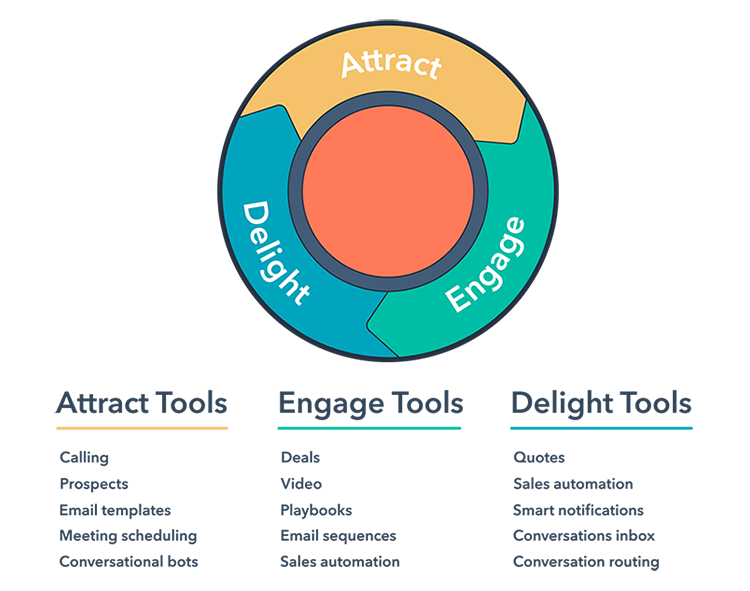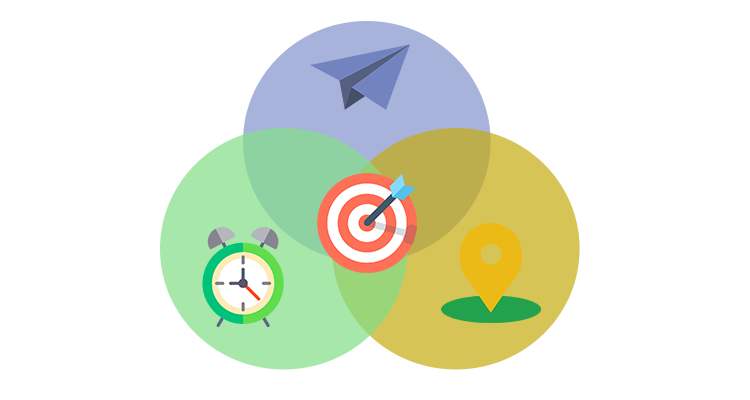Only a few seconds to read us? Here is a straight-to-the-point version of this article!
In 2006, Brian Halligan and Dharmesh Shah first came up with the expression “inbound marketing”. Many years later, this strategy has crossed the oceans and found lots of adopters in companies around the world. What about yours?
If you are considering trying inbound marketing this year, here are 3 good reasons to start right now!
Summary
- #1 Inbound strategy: Right Message + Right Time + Right Place = Right Audience
- #2 Inbound marketing: performance based on investment optimization
- #3 Inbound strategy: complementary and sustainable
- Want to try it? Here are a few tips to start!
What is inbound marketing ?
This expression had many definitions since it was used for the very first time. And you can find so many books on this topic now! So, my point here is not to redefine inbound marketing once again. I will rather tell you about its current challenges, and also introduce a new vision based on HubSpot’s Flywheel.
Inbound marketing is about every action aiming at attracting spontaneously new leads and customers to a company. And to do this, marketers offer valuable content and services to answer their visitors’ needs.
Then, content marketing and SEO are central to an inbound marketing strategy. Companies using it must make its content visible online to appeal to leads and customers.
For sure, inbound marketing is for attracting more traffic on your website. But more than that, it is also for converting them into prospects, and then into clients. Visually, it takes the shape of a marketing funnel showing the contact steps from visitor to customer.
At each step, companies can use several tools and actions to convert leads and take them down the funnel. For example, blogging, product demos or lead nurturing can all help a lot to turn leads into new clients.
At HubSpot’s Inbound 2018 conference, co-founder Brian Halligan first announced the end of the marketing funnel. Besides, he introduced a new model to change the vision of inbound marketing: the Flywheel.
With the funnel concept, a lead came through several steps, and each step involved different resources in the company. On the opposite, the Flywheel brings the lead at the center of the process. The company and its resources are now coming all around to satisfy leads and convert them in the end.
This also implies that the Flywheel goes cyclic with a lead-centric vision. Besides, the funnel comes to an end at the moment a lead turns into a customer. With a Flywheel vision, the company is not expected to stop marketing and sales efforts once the closing is done. They will keep on striving to answer their customers’ needs and stimulate their own growth process.
Of course, the Flywheel concept is not the absolute opposite to the funnel. Both have a lot in common, may it be the Attract / Engage / Delight steps, or the tools in action to convert. By the way, these tools are getting more and more conversational, for example chatbots.
If you are interested in this specific Flywheel concept, please have a look at the dedicated article on HubSpot blog. The video of Brian Halligan’s keynote will also bring you some clear insights.
#1 Inbound Strategy: Right Message + Right Time + Right Place = Right Audience
Today, leads and customers do no longer want us to come to them to sell our products. They want to find and try by themselves the right solutions for the needs they had defined, more or less.
In our digital era, customers can search and find information in autonomy, and compare products and services whenever they need to. In such context, outbound marketing techniques are losing sense for customers, and therefore for companies too. Inbound marketing is becoming the new logic for this consumption pattern ruled by customers.
The Right Message
This strategy aims at delivering useful and relevant information to your prospects. There are many ways to adapt your communication to your leads. Blog posts, success stories, e-books, videos, and these are just a few examples. In any case, your goal is to bring your future clients the adequate solution or message, with no interruption.
At the Right Time
There is nothing such as good timing to skyrocket your marketing message. Having the right solution is fine, but you also need to bring it up at the right time. And this means you have to adapt it to your lead’s maturity level.
Inbound marketing allows you to be more flexible in the way you present your solutions. The thing is that you can produce adapted content for both beginners and advanced audiences. Then, you bring the right message to your leads, no matter their position in the sales cycle.
In the Right Place
Each of us has his or her own habits when it comes to finding and consuming information. You can refer to one or more search engines, search on specialized websites, social media, … And these digital spaces can also depend on the business type (B2C or B2B) and domain (real estate, automotive, etc.).
What you have left now is to deliver your message in the right place. With an inbound marketing strategy, you can reach your leads wherever they are. Find out the content and platforms they like and visit to share your own message or content there.
And this all gets to the Right Audience!
Right message, right time, right place. This perfect combo makes it to the right audience for you and the message you are conveying through inbound marketing. And for sure, reaching your ultimate target audience means optimized performance for your marketing.
#2 Inbound marketing: performance based on investment optimization
Target audience = already qualified prospects
Inbound marketing makes your company communicating about your products and solutions by answering specific needs expressed by your audience. So, the leads who are exposed to this information already belong to your target audience. Even more, you can say they are already qualified for next steps in some way!
In the case of more traditional marketing actions, you happen not to control your audience that much. For print, radio, TV spots, or mass emailing, could you tell as precisely who exactly your message will appeal to? Inbound marketing makes your efforts more rational and efficient.
Automated lead processing & shortened sales cycles
For over 10 years, a panel of automation tools has come to support inbound marketers’ actions. With these tools, you can for example automatically get back to a lead who is not yet ready to buy. To get further through the conversion process, you’ll have to send him some content adjusted to his maturity level. This is lead nurturing.
Once again, you can send this content in different ways, depending on which channels your company is using. This can be email, SMS, messaging on social media, displaying banners on search engines or referral websites, and so on.
With this accurate and automated targeting and lead management, you can better qualify leads before processing them to sales teams. Then, the sales cycles are also optimized and shortened, which makes your company grow faster in the end.
Performance-driven investments
Inbound marketers don’t spend money, they invest it. “Same thing.”, you would say. Not really, because when investing, a company doesn’t look for reducing costs, but for optimizing them according to their performance!
By doing inbound marketing, your company is investing on several mediums, channels and resources to generate qualified leads. And these investments can be more or less efficient.
Therefore, you need to establish the ROI (Return on Investment) of each of your marketing actions. This will help you to accurately measure their efficiency, and allocate your budgets to the best-performing channels.
Inbound marketing is a data-driven strategy, and measuring ROI is its key milestone. Thanks to this, not only you are aware of your campaigns’ efficiency, but you are also improving it constantly. And that can bring you loads of new leads!
Same way than for automation, many tools are available to help you measure your marketing ROI easily and quickly. Google Analytics, of course, but also social media analytics tools, call tracking, …
#3 Inbound strategy: complementary and sustainable
Inbound and outbound marketing, the ultimate combo?
One of the main strengths of inbound marketing is that it can easily evolve and be adjusted independently of other strategies. By the way, inbound marketing does not the contrary of outbound marketing. They are even complementary in some way.
In marketing, like in many other domains, there is not a single and right way to do things. I would never advise you to invest everything you have in inbound marketing. Sure, this strategy can efficiently complete your existing campaigns and actions. But it will never completely replace outbound marketing if it is working for you.
Before in this article, I told you today’s consumers did no longer want to be targeted by intrusive and aggressive campaigns. But this is not even a small part of what outbound marketing can be. Of course, respectful, smart and constructive outbound campaigns can be tremendously effective.
And this is precisely the point about Account-Based Marketing, for example. Even if based on outbound tactics, this strategy has a lot in common with inbound marketing, especially when it comes to build a personalized approach.
So, there are lots of possibilities regarding outbound marketing as well. What you can do for your own strategy is to use both inbound and outbound marketing in a relevant way.
Like a good wine, your inbound strategy will need time to improve!
An inbound marketing strategy is sustainable and based on long-term results. As time goes by, your inbound performance will only get better.
But how? The fact is the more years you will be doing it, the more high-quality content you will save. Your position in search results and social media will strenghten, especially in the places where your target audience is!
Besides, you will also gain experience at constantly trying new marketing channels (still with consideration to your ROI, of course). Ultimately, you will become a true expert in your domain and as an inbound marketer.
Want to try it? Here are a few tips to start!
Just like us and many other companies, if you are convinced of the potential and efficiency of inbound marketing, good for you! This year is the perfect opportunity for you to start.
You already have some webmarketing and content marketing skills? That’s great, but still remember, launching an inbound strategy is about a whole new thing. The good thing is that inbound marketing benefits a lot… from itself! There are plenty online resources to help you along.
Of course, there are specialized blogs like HubSpot’s, where you can find some valuable advice. You can also refer to a digital agency for your first steps with inbound marketing. Last but not least, some books from experts like Seth Godin can help you as well.
In a nutshell:
Inbound marketing is a strategy that succeeded in becoming a must-have for many marketers, for more than 10 years now.
Here, we do no longer talk about prospecting outside. Inbound marketing aims at attracting prospects to companies with content, data and expertise. By doing so, it perfectly matches with consumers’ new expectations. Here are 3 good reasons for you to try it too:
#1 Right Message + Right Time + Right Place = Right Audience
With a relevant marketing message, displayed in valuable content with regards to your prospects’ maturity, you will shine for sure. Pay attention that your resources are available in the specific places where your leads are searching and finding data. This way, you will easily promote your products and services to your target audience.
Thanks to inbound marketing, you can simply address the prospects who really count for your company. The ones who can really benefit from your products or solutions.
#2 A performant strategy based on investment optimization
Such an accurate targeting allows you to get in touch with already qualified prospects. And this is a great thing for your overall marketing performance. What’s more, you can use many inbound marketing tools today to automate lead processing. Then, your sales teams will manage already mature contacts. As for you, il will be an opportunity to measure, analyze and optimize your marketing investments.
As an inbound marketer, you can constantly optimize your campaigns as you are running them. The sales cycles are also reduced in time because your leads are more mature. And all of this allows you to increase marketing performance day after day.
#3 Complementary and sustainable: start a marketing virtuous circle!
Be careful though, inbound marketing is not the ultimate strategy that will bring you everything. The point of it is to efficiently complete your existing marketing actions, and namely outbound marketing. The more complementary approaches you have, the more diversified your acquisition will be. Eventually, you will depend less on each of your marketing acquisition channel.
Moreover, inbound marketing is a long-term strategy. Just like SEO, it will bring better results if you make it sustainable for your company. This is about starting a virtuous circle: with smart investments based on clear results, your inbound actions will gain efficiency over the years.







